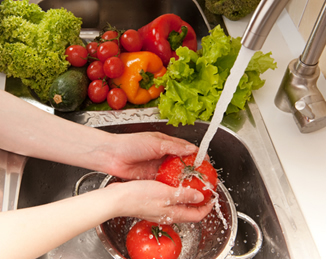Upon receipt of the "Manual of Healthy School Canteens: promoting healthy eating”, private school canteen owners gained new information on how to transform them into healthy canteens. This was an initiative of the Ministry of Health in partnership with the National Federation of Private Schools (FENEP), as one of the actions foreseen in the technical cooperation agreement signed between them this year.

Manual of Healthy School Canteens: promoting healthy eating*
One of the aspects addressed in this material concerns the hygiene of food, because to be healthy, not it is enough to contain the essential nutrients for the body, the food must also be free of any kind of Contamination.
This is an important point because more and more cases of food infection are reported. To give you an idea, around 30% of the population in developed countries contract diseases through food. One example occurred in Germany, where the Reuters News Agency reported that an outbreak of AND.coli caused panic and caused the closure of a school.
So, what can you, the owner of a school canteen or any other commercial establishment that works with food, do to avoid these risks? Below, we have some tips that can be seen in a more comprehensive way in the mentioned Manual.
But, before following these tips, the first thing you should do is look for a qualified professional, such as a nutritionist, to prepare a Handbook of Good Practices for Food Services, which is mandatory for all canteens, according to Resolution RDC ANVISA No. 216, of September 2004.
1. Employee hygiene:
Employees must be clean, take a shower daily, wash their hands always with soap and water and then apply 70% alcohol, especially when they go to the bathroom, come from the street or perform activity, being without a beard, jewelry, long or painted nails, wearing clean caps and uniform, not talking over food, not being sick or injured in the hands and not taking money.

2. Environmental hygiene:
Clean canteen facilities, such as walls, floors and ceilings, as well as equipment and utensils that will be used with soap and water. Afterwards, disinfect the internal parts of the equipment with 70% alcohol and on the internal parts apply a solution with 10 mL of bleach to 1 liter of water and leave for 15 minutes. Carry out periodic fumigation, put screens on doors and windows, keep garbage closed and the place where food is prepared should be separated from where it is sold.

3. Food hygiene:
Take care that your food supplier has the products in an excellent state of hygiene, store the food first refrigerated, followed by frozen and, finally, food at room temperature and always clean the packaging before save them.

In the article “Tips for buying and preparing healthier foods”, you will find tips on how to buy, clean, prepare and store food. Also remember that once food has been prepared, it can only be left at room temperature for a maximum of 30 minutes; if they are hot, they should be kept in an oven, stove or stove; and if they are cold, they should be kept in the fridge or freezer.
*Image taken from the website: http://189.28.128.100/nutricao/docs/geral/manual_cantinas.pdf
By Jennifer Fogaça
Graduated in Chemistry
Source: Brazil School - https://brasilescola.uol.com.br/saude-na-escola/higiene-dos-alimentos-cantinas-escolares.htm
